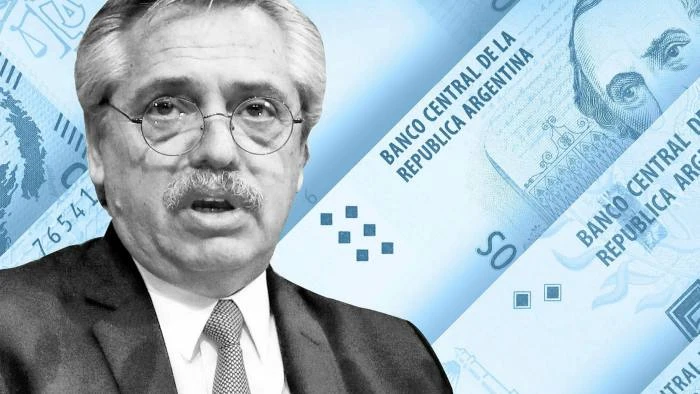
Argentina has taken a series of steps to help steady its volatile currency in recent weeks, but investors still fear authorities will be forced into another devaluation of the official rate if they do not come up with a comprehensive and credible plan to revive the troubled economy.
Support for the peso has stemmed from a rise in interest rates, the issue of a new dollar-linked peso bond worth $1.6bn, a pledge to refrain from government spending with new money printed by the central bank, and assurances from economy minister Martin Guzmán that the fiscal deficit will be cut “more than expected” next year.
Analysts and investors said these are signs of a welcome shift towards greater economic orthodoxy from the leftist government of President Alberto Fernández. But many fear the moves will not be enough to staunch the haemorrhaging of central bank reserves. Net liquid reserves, excluding gold, are now close to zero.
“It’s not going to work. All the measures of late are simply Band-Aids that do not tackle the core problem,” said Alejo Czerwonko, chief investment officer for emerging markets in the Americas at UBS Global Wealth Management. It is “inevitable” that authorities will have to set the official peso rate at a much weaker level, he said. That would be the seventh such move in the past two decades.
Market nerves are still clear in Argentina’s government bonds. Since a successful restructuring of $65bn of foreign debt in early August, the price of Argentina’s benchmark bond maturing in 2035 has fallen from 46 cents on the dollar to 37 cents, deep into “distressed” territory, betraying concerns that the country could default on its sovereign debt for a tenth time.
Meanwhile, the gap between the official and unofficial exchange rates, a reliable indicator of investor confidence, has reached the highest level in decades. The value of the dollar on the black market shot up from around 130 pesos in early August to more than 190 pesos in late October, although it has since fallen back to around 150 pesos in response to the state efforts at support. The official exchange rate has moved more slowly, with the dollar climbing since August from 72 pesos to 79 pesos.

“Either they solve the underlying situation and stop the fiscal bleeding, and start absorbing some pesos [to] anchor the currency, or they continue with short-term stop-gap measures that just delay the inevitable [devaluation],” said Diego Ferro, founder of M2M Capital Management.
He described the aftermath of the debt restructuring as a “bad joke”, given that normally, debt relief provides a fresh start that fuels a market rally. But “it was so poorly planned that it was wasted. Without a [macroeconomic] plan, all the goodwill generated lasted about a week . . . it’s hard to think that they will not have to restructure again”.
Nevertheless, some observers note a growing sense of urgency in the Peronist government given the peso’s recent gyrations, leading to speculation that an agreement with the IMF to restructure the $44bn it has lent since a currency crisis in 2018 could be made sooner than analysts and investors had assumed, with many initially expecting a deal by March or April next year.
A new IMF programme, including extending maturities of Argentina’s existing debt with the lender, would help to restore investor confidence, given that it would likely come with conditions including a commitment to a clear economic plan. But it would also provide an opportunity to seek fresh money from the IMF to help finance the fiscal deficit without resorting to printing money. People close to the negotiations believe officials are now more willing to go down this route, despite previously discarding the possibility.
“I would recommend [borrowing more money from the IMF], because to stabilise the economy, it is central to strengthen [foreign exchange] reserves,” said Emmanuel Alvarez Agis, who runs PxQ, an economic consultancy in Buenos Aires. Capital controls, he argued, will prevent new IMF money from financing capital flight, as happened after the 2018 crisis.
A former deputy economy minister under the previous Peronist government in 2013-15, who has recently been critical of economic policy, Mr Alvarez is more sanguine about recent developments than many market participants: “The government has started to apply a stabilisation plan that makes sense. If they continue this way, it is probable that the gap [between the official and parallel exchange rates] will return to reasonable levels,” he added.
Daniel Marx, a former finance secretary, warns that the current situation is “fragile”, fearing that it will be “very difficult” to reverse the trend of declining foreign exchange reserves. “Money from the IMF will help, but it is not as important as creating [an economic] framework that enables capital inflows, rather than outflows.”
Ultimately, foreign exchange pressures will not abate until Argentina presents a credible path to sustainable fiscal accounts, argued Mr Czerwonko.
Given low interest rates in developed markets, global investors are engaged in “an aggressive search for yield”, he said. “If Argentina sends the right messages, the market could quickly change its perception of the country.”




















